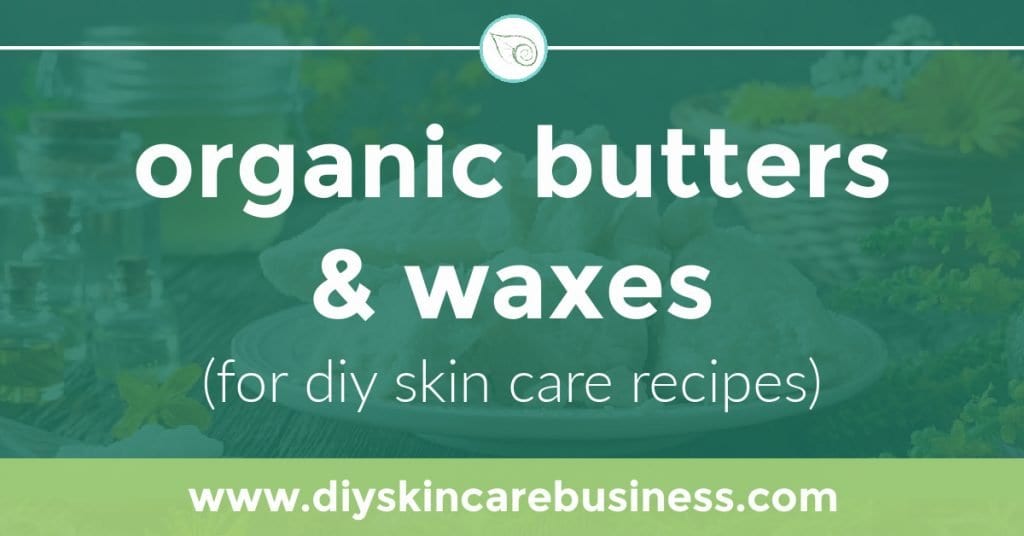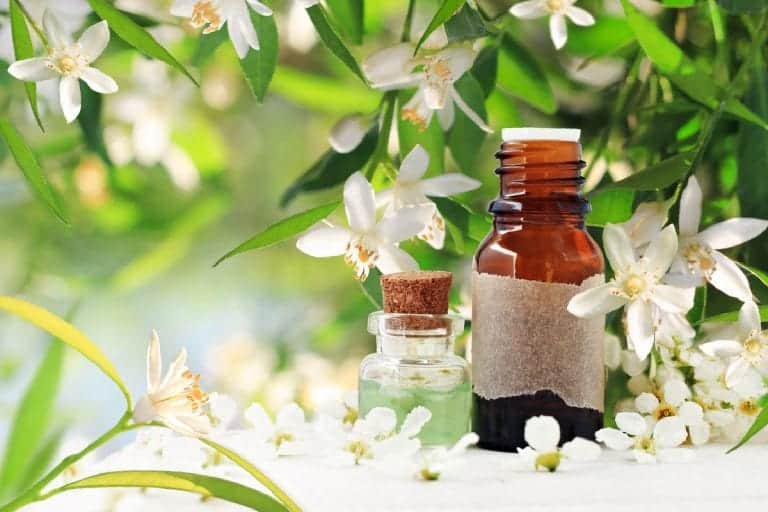Organic butters and waxes are essential to natural skin care formulas because they deeply penetrate the skin, absorbing several layers down for cell regeneration and hydration.
Great news for skin care entrepreneurs: you don’t need a huge back stock for your handmade business.
In fact, keeping it simple will ensure that your ingredients remain fresh, providing your customers with products that have a healthy shelf life.
This is a very general post that gives an aerial view of butters and beeswax, how to use them, as well as FIVE organic and unrefined options will easily fill your product line with effective, rich, moisturizing properties and amazing results.

This post may contain affiliate links, meaning I get a commission if you decide to make a purchase through my links (at no cost to you). Please read the disclosure for more information.
What are Butters and Waxes for Skin Care?
Natural butters used in skin care are created from the fruits, seeds, and nuts of trees. They are cold-processed or grilled/roasted to open up their properties.
They are highly nourishing to the skin and increase hydration, prevent chapping, and restore the epidermis.
These solid ingredients also help to thicken and harden skin care formulations so that they’re easy to apply based on the intended use of the final product.

What are the Best Butters and Waxes for Skin?
Just as with carrier oils, the ‘best’ butter to use depends on the type of skin applied to and the desired outcome.
Though they are all nourishing and moisturizing, every butter and wax has its own list of benefits and properties (details below).
You can absolutely use more than one (or three!) butters plus beeswax in your recipes. In fact, I’d recommend it – combining the benefits of various ingredients is very effective for natural skin care.
Organic and unrefined versions of raw ingredients (you’ll also see them labeled as ‘crude’ by some vendors) are always the best bet for skin care recipes; when refined, the solvents used in the process damage and strip the ingredients of their natural vitamins and benefits.

How to Use Butters and Waxes in Skin Care
Butters and waxes need to be melted down in order to be combined with other ingredients (such as carrier oils and essential oils) to make balms, creams, and salves.
This is best achieved on a stovetop by using a double boiler on low to medium heat.
Generally speaking, you melt ingredients in an intentional order from the hardest (usually beeswax or cocoa butter depending on the recipe) down to the softest (usually coconut oil).
The exception is shea butter, which should be added after all other ingredients are melted down and the pot removed from the heating element.
As a maker, you can control the hardness of a recipe with the amount of carrier oils added to your blend.
Even one teaspoon variance of carrier or beeswax can make a huge difference to the end result of a product – take the time to experiment and get to know the personalities of your ingredients.
Some butters reset to their final hardness within an hour once removed from heat, whereas others take up to 24 hours to reach their final state – when making a new recipe, give it a full day to rest after melting and pouring into containers before deciding if you have a winning ratio for the intended use.
Top 5 Butters and Waxes for Skin Care Makers
The four butters (plus beeswax) below are the only hard ingredients I used in my skin care shop for years – they are the basics for any handmade business.
Get to know these intimately, as you’ll be working closely with them for your entire skin care making career:
ORGANIC BEESWAX
(Cera alba)
Source: Honeycomb of the honeybee
Shelf Life: None (store cool and covered)
Benefits: Beeswax locks in moisture and protects skin by creating a barrier from the environment without clogging pores.
Due to the high levels of Vitamin A in beeswax, it is also said to aid in natural healing and cell development.
Beeswax has a high melting point of 143 – 151 degrees Fahrenheit (F), which helps to solidify skin care products (bonus: keeps your shipped products from melting in transit during warmer months or climates).
ORGANIC COCOA BUTTER
(Theobroma cacao)
Source: Roasted seeds of cocoa trees
Shelf Life: ~2 years (longer if stored cold)
Benefits: Pure cocoa butter is one of the most hydrating butters and is full of vitamins, antioxidants, and fats that no other natural skin care ingredient can claim.
There is no real cocoa butter substitute, as it has an amazing ability to lock in moisture, provide sun protection, lighten dark spots and discolorations, and has been credited for helping to diminish the appearance of stretch marks and scars.
Skin Care Recipes that Use Cocoa Butter:
- Organic belly balm recipe
- Organic cuticle salve recipe
- Cold process shaving soap bar recipe (in this soap recipe bundle)
- Warming muscle balm recipe
ORGANIC COCONUT OIL, 76°
(Cocos nucifera)
Source: Flesh from inside a coconut shell
Shelf Life: 2 years
Benefits: Coconut oil is a popular oil due to its quick absorption, slight SPF, antibacterial and antimicrobial properties.
Solid coconut oil has a low melting point (of 76° F) and is added to recipes that are meant to remain a bit thicker, yet melt on contact with skin for easy application.
Skin Care Recipes that Use 76° Coconut Oil:
- Organic lip balm recipe
- Organic belly balm recipe
- Organic under-eye salve recipe
- Cold process shaving soap bar recipe (in this soap recipe bundle)
- Warming muscle balm recipe
ORGANIC MANGO BUTTER
(Mangifera indica)
Source: Mango seeds
Shelf Life: ~1 year
Benefits: Mango Butter is a solid, thick butter that slowly melts when applied to skin due to body heat.
It is similar to shea and cocoa butter, all higher in fatty acids and antioxidants (which makes them super moisturizing).
The most praise-worthy of mango butter benefits is its ability to promote cell regeneration, making it fantastic for dealing with scarring and stretch marks.
Skin Care Recipes that Use Mango Butter:
ORGANIC SHEA BUTTER
(Vitellaria paradoxa)
Source: Seeds from the Karite tree
Shelf Life: ~1 year
Benefits: The benefits of shea butter are far-reaching and unparalleled in skin care. It is an intense moisturizer and deeply penetrates the skin.
It goes so far as to revitalize skin cells, making it a fantastic addition to recipes for sun damage, postpartum skin care, and mature skin formulations.
Beneficial for the long-term health of the skin.
Skin Care Recipes that Use Shea Butter:
These five organic butters and waxes are the only solid ingredients used in the natural skin care recipes available on our site.
Head over to the Natural Skin Care Recipes section to get some winning ideas for your own handmade skin care line!
Grow Your Skin Care Business!
Browse through the resources below to boost your handmade business visibility and profitability!








